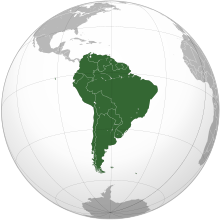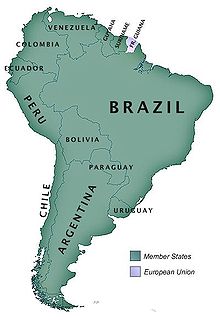 | |
| Area | 17,840,000 km2 (6,890,000 sq mi) (4th) |
|---|---|
| Population | 434,254,119 (2021; 5th)[1][2] |
| Population density | 21.4/km2 (56.0/sq mi) |
| GDP (PPP) | $7.61 trillion (2022 est; 5th)[3] |
| GDP (nominal) | $3.62 trillion (2022 est; 4th)[4] |
| GDP per capita | $8,340 (2022 est; 5th)[5] |
| Religions |
|
| Demonym | South American |
| Countries | |
| Dependencies | |
| Languages | |
| Time zones | UTC−02:00 to UTC−05:00 |
| Largest cities | |
| UN M49 code | 005 – South America419 – Latin America and the Caribbean019 – Americas001 – World |

South America is a continent[h] entirely in the Western Hemisphere[i] and mostly in the Southern Hemisphere, with a considerably smaller portion in the Northern Hemisphere. It can also be described as the southern subregion of the Americas.
South America is bordered on the west by the Pacific Ocean and on the north and east by the Atlantic Ocean; North America and the Caribbean Sea lie to the northwest.
The continent includes twelve sovereign states: Argentina, Bolivia, Brazil, Chile, Colombia, Ecuador, Guyana, Paraguay, Peru, Suriname, Uruguay, and Venezuela; two dependent territories: the Falkland Islands and South Georgia and the South Sandwich Islands;[j] and one internal territory: French Guiana.[k]
The ABC islands of the Dutch Caribbean (north of Venezuela in the Leeward Antilles), Ascension Island (a part of Saint Helena, Ascension and Tristan da Cunha), Bouvet Island (a dependency of Norway), Panama, and the Caribbean island country of Trinidad and Tobago may also be considered parts of South America.
South America has an area of 17,840,000 square kilometers (6,890,000 sq mi). Its population as of 2021[update] has been estimated at more than 434 million.[1][2] South America ranks fourth in area (after Asia, Africa, and North America) and fifth in population (after Asia, Africa, Europe, and North America). Brazil is by far the most populous South American country, with almost half of the continent's population, followed by Colombia, Argentina, Venezuela, and Peru. In recent decades, Brazil has also generated half of the continent's GDP and has become the continent's first regional power.[8]
Most of the population lives near the continent's western or eastern coasts while the interior and the far south are sparsely populated. The geography of western South America is dominated by the Andes mountains; in contrast, the eastern part contains both highland regions and vast lowlands where rivers such as the Amazon, Orinoco and Paraná flow. Most of the continent lies in the tropics, except for a large part of the Southern Cone located in the middle latitudes.
The continent's cultural and ethnic outlook has its origin with the interaction of Indigenous peoples with European conquerors and immigrants and, more locally, with African slaves. Given a long history of colonialism, the overwhelming majority of South Americans speak Spanish or Portuguese, and societies and states are rich in Western traditions. Relative to Africa, Asia, and Europe, post-1900 South America has been a peaceful continent with few wars,[9][10][l] although high rates of violent crime remain a concern in some countries.[12][13]
- ^ a b "World Population Prospects 2022". United Nations Department of Economic and Social Affairs, Population Division. Retrieved 17 July 2022.
- ^ a b "World Population Prospects 2022: Demographic indicators by region, subregion and country, annually for 1950-2100" (XSLX) ("Total Population, as of 1 July (thousands)"). United Nations Department of Economic and Social Affairs, Population Division. Retrieved 17 July 2022.
- ^ "GDP PPP, current prices". International Monetary Fund. 2022. Archived from the original on 22 January 2021. Retrieved 16 January 2022.
- ^ "GDP Nominal, current prices". International Monetary Fund. 2022. Archived from the original on 25 February 2017. Retrieved 16 January 2022.
- ^ "Nominal GDP per capita". International Monetary Fund. 2022. Archived from the original on 11 January 2020. Retrieved 16 January 2022.
- ^ a b c "The Global Religious Landscape" (PDF). Pewforum.org. Archived from the original (PDF) on 25 January 2017. Retrieved 7 May 2020.
- ^ Ambassador Rubens A. Barbosa. "Mercosul in the Regional Context". Archived from the original on 30 September 2006. Retrieved 19 May 2007.
- ^ Schenoni, Luis L. (1 January 1970). "Unveiling the South American Balance". Estudos Internacionais 2(2): 215–232. Archived from the original on 12 May 2020. Retrieved 8 December 2016.
- ^ Holsti 1996, p. 155.
- ^ a b Franchi, Tássio; Ferreira Glaser Migon, Eduardo Xavier; Jiménez Villarreal, Roberto Xavier (2017). "Taxonomy of interstate conflicts: is South America a peaceful region?". Brazilian Political Science Review. 2 (11). doi:10.1590/1981-3821201700020008. ISSN 1981-3821.
- ^ Terradas, Nicolás (26 May 2021). "The Latin American Long Peace". Oxford Research Encyclopedia of International Studies. doi:10.1093/acrefore/9780190846626.013.587. ISBN 978-0-19-084662-6 – via oxfordre.com.
- ^ "Homicide and Organized Crime in Latin America and the Caribbean" (PDF). United Nations Office on Drugs and Crime. 2023. Retrieved 15 May 2024.
- ^ "Homicide rates in selected Latin American and Caribbean countries 2023". Statista. Retrieved 15 May 2024.
Cite error: There are <ref group=lower-alpha> tags or {{efn}} templates on this page, but the references will not show without a {{reflist|group=lower-alpha}} template or {{notelist}} template (see the help page).